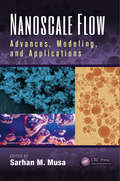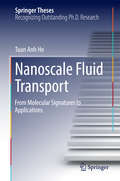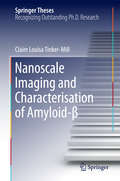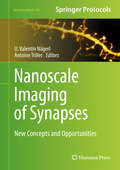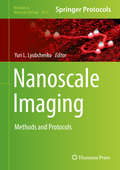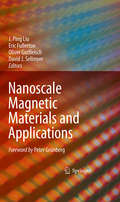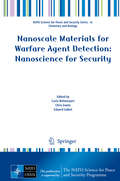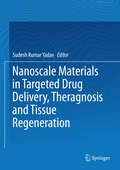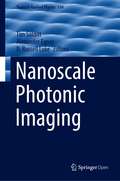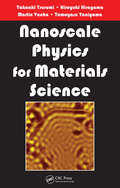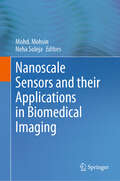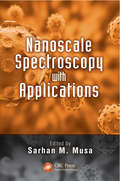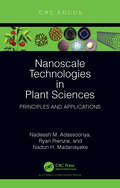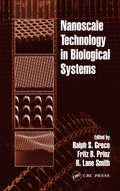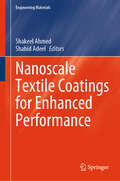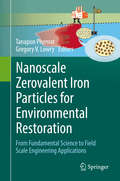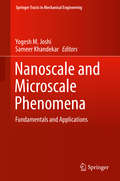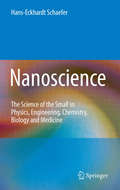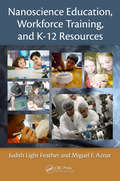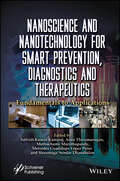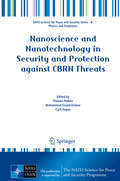- Table View
- List View
Nanoscale Flow: Advances, Modeling, and Applications
by Sarhan M. MusaUnderstanding the physical properties and dynamical behavior of nanochannel flows has been of great interest in recent years and is important for the theoretical study of fluid dynamics and engineering applications in physics, chemistry, medicine, and electronics. The flows inside nanoscale pores are also important due to their highly beneficial drag and heat transfer properties. Nanoscale Flow: Advances, Modeling, and Applications presents the latest research in the multidisciplinary area of nanoscale flow. Featuring contributions from top inventors in industry, academia, and government, this comprehensive book: Highlights the current status of research on nucleate pool boiling heat transfer, flow boiling heat transfer, and critical heat flux (CHF) phenomena of nanofluids Describes two novel fractal models for pool boiling heat transfer of nanofluids, including subcooled pool boiling and nucleate pool boiling Explores thermal conductivity enhancement in nanofluids measured with a hot-wire calorimeter Discusses two-phase laminar mixed convection AL2O3–water nanofluid in an elliptic duct Explains the principles of molecular and omics imaging and spectroscopy techniques for cancer detection Analyzes fluid dynamics modeling of the tumor vasculature and drug transport Studies the properties of nanoscale particles and their impact on diagnosis, therapeutics, and theranostics Provides a brief background and review of medical nanoscale flow applications Contains useful appendices of physical constants, equations, common symbols, mathematical formulas, the periodic table, and more A valuable reference for engineers, scientists, and biologists, Nanoscale Flow: Advances, Modeling, and Applications is also designed for researchers, universities, industrial institutions, and government, giving it broad appeal.
Nanoscale Fluid Transport
by Tuan Anh HoThis thesis demonstrates how molecular modeling techniques can be used to gain significant insights into numerous applications that are increasingly attracting research interest because of their societal importance. It presents innovative ideas that, by altering the fundamental physical phenomena occurring at the solid/liquid interface, allow the fluid transport in nanochannels to be manipulated so as to improve the performance of the practical applications. The applications explicitly considered in this thesis are the design of drag-reducing and self-cleaning surfaces; water desalination; and shale gas exploration - all of which are, to some extent, governed by nanoscale fluid transport. Overall, this thesis is useful for students and researchers entering the field who wish to understand how molecular modeling can improve the performance in a wide range of applications.
Nanoscale Imaging and Characterisation of Amyloid-β
by Claire Louisa Tinker-MillThis thesis presents a method for reliably and robustly producing samples of amyloid-β (Aβ) by capturing them at various stages of aggregation, as well as the results of subsequent imaging with various atomic force microscopy (AFM) methods, all of which add value to the data gathered by collecting information on the peptide's nanomechanical, elastic, thermal or spectroscopical properties. Amyloid-β (Aβ) undergoes a hierarchy of aggregation following a structural transition, making it an ideal subject of study using scanning probe microscopy (SPM), dynamic light scattering (DLS) and other physical techniques. By imaging samples of Aβ with Ultrasonic Force Microscopy, a detailed substructure to the morphology is revealed, which correlates well with the most advanced cryo-EM work. Early stage work in the area of thermal and spectroscopical AFM is also presented, and indicates the promise these techniques may hold for imaging sensitive and complex biological materials. This thesis demonstrates that physical techniques can be highly complementary when studying the aggregation of amyloid peptides, and allow the detection of subtle differences in their aggregation processes.
Nanoscale Imaging of Synapses
by U. Valentin Nägerl Antoine TrillerSynapses underlie rapid and flexible neural communication in the brain and they hold the key to understanding higher brain functions in health and disease. Because they are very small and highly dynamic, it is very difficult to study them with traditional techniques. Fortunately, recent ground-breaking advances in optical microscopy (e. g. STED, PALM, STORM, SIM) have greatly improved our ability to image living synapses at the nanoscale, even down to the level of single molecules. The proposed volume brings together leading researchers to review these exciting new techniques and their application in neurobiological research. It will explain and discuss the basic principles behind the various superresolution modalities, how they are implemented, what their scope and limitations are etc. In addition, several key research discoveries on synapses enabled by these novel approaches will be highlighted.
Nanoscale Imaging: Methods and Protocols (Methods in Molecular Biology #1814)
by Yuri L. LyubchenkoThis volume presents readers with the latest techniques to study nanoimaging and nanoprobing in application to a broad range of biological systems. The chapters in this book are divided into five parts, and cover topics such as imaging and probing of biomacromolecules including high-speed imaging and probing with AFM; probing chromatin structure with magnetic tweezers; and fluorescence correlation spectroscopy on genomic DNA in living cells. Written in the highly successful Methods in Molecular Biology series format, chapters include introductions to their respective topics, lists of the necessary materials and reagents, step-by-step, readily reproducible laboratory protocols, and tips on troubleshooting and avoiding known pitfalls.Cutting-edge and through, Nanoscale Imaging: Methods and Protocols is a valuable resource for anyone interested in learning more about this developing and expanding field.
Nanoscale Magnetic Materials and Applications
by Oliver Gutfleisch J. Ping Liu D. J. Sellmyer Eric FullertonNanoscale Magnetic Materials and Applications covers exciting new developments in the field of advanced magnetic materials. Readers will find valuable reviews of the current experimental and theoretical work on novel magnetic structures, nanocomposite magnets, spintronic materials, domain structure and domain-wall motion, in addition to nanoparticles and patterned magnetic recording media. Cutting-edge applications in the field are described by leading experts from academic and industrial communities. These include new devices based on domain wall motion, magnetic sensors derived from both giant and tunneling magnetoresistance, thin film devices in micro-electromechanical systems, and nanoparticle applications in biomedicine. In addition to providing an introduction to the advances in magnetic materials and applications at the nanoscale, this volume also presents emerging materials and phenomena, such as magnetocaloric and ferromagnetic shape memory materials, which motivate future development in this exciting field. Nanoscale Magnetic Materials and Applications also features a foreword written by Peter Grünberg, recipient of the 2007 Nobel Prize in Physics.
Nanoscale Materials for Warfare Agent Detection: Nanoscience for Security (NATO Science for Peace and Security Series A: Chemistry and Biology)
by Carla Bittencourt Chris Ewels Eduard LlobetThis book presents a blueprint for researchers in the area of nanotechnology for chemical defense, especially with regard to future research on detection and protection. It addresses the synthesis of complex nanomaterials with potential applications in a broad range of sensing systems. Above all, it discusses novel experimental and theoretical tools for characterizing and modeling nanostructures and their integration in complex systems. The book also includes electronic structure calculations exploring the atomic and quantum mechanical mechanisms behind molecular binding and identification, so as to provide readers with an in-depth understanding of the capabilities and limitations of various nanomaterial approaches. Gathering contributions by scientists with diverse backgrounds, the book offers a wealth of insightful information for all scientists whose work involves material science and its applications in sensing.
Nanoscale Materials in Targeted Drug Delivery, Theragnosis and Tissue Regeneration
by Sudesh Kumar YadavThis book is the first of its kind to offer a comprehensive and up-to-date discussion of the use of nanoscale materials for biomedical applications, with a particular focus on drug delivery, theragnosis and tissue regeneration. It also describes in detail the methods used in the preparation of nanoparticles. Response of nanoparticles in biological systems are also explored. Nanotechnology has led to the advent of a new field, nanomedicine, which focuses on the use of nanomaterials as drug-delivery vehicles to develop highly selective and effective drugs. The combination of molecular imaging and nanotechnology has produced theragnostic nanoparticles, which allow the simultaneous detection and monitoring of diseases. Nanotechnology can also be combined with biomaterials to create scaffolds for tissue regeneration. Further, significant advances have been made in the areas of drug delivery, theragnostic nanoparticles and tissue regeneration materials. Some nanomedicines and tissue regeneration materials are already commercially available, while others are undergoing clinical trials, and promising results have been documented. Despite the rapid advances in nanomedicine, there is a relative dearth of literature on the biomedical applications of nanoscale materials.
Nanoscale Matter and Principles for Sensing and Labeling Applications (Advanced Structured Materials #206)
by Dambarudhar Mohanta Purushottam ChakrabortyThis book is a compilation of carefully chosen chapters that cover the subjects of nanoscale matter, sensing, and labelling applications. It is aimed primarily at scientists and researchers who are already involved in theme-based research or who are just starting their careers. Despite the diverse nature of the topics covered, which include a range of materials in various forms and uses, the emphasis is primarily on sensing and labelling phenomena. The book begins with materials quantification in nanoscale systems by using an innovative technique like “molecular secondary ion mass spectrometry without calibration standards”. Subsequently, the book features an array of materials such as inorganic semiconductor nanoscale particles, carbon dots, rare-earth oxides, polymer nanocomposites, and a few biomaterials, all of which illustrate their functionality and potential for deployment in a wide variety of sensing applications. Although the book delves into the technical aspects of fabrication workouts to some extent, the focus is predominantly on the physical principles, mechanisms, and relevance involved in sensing and labelling applications. The book covers a wide range of topics that leverage the unique properties of nanoscale materials. By carefully selecting appropriate active materials, the authors explore the detection of LPG, hazardous and explosive gases, as well as humidity sensing and hydrogen evolution. It also delves into photo-sensing and persistent photoconductivity by using nanoscale semiconductors, which are used for heavy metal sensing and UV sensing, respectively. The use of metal nanoparticles in various forms is reviewed to address issues related to water contamination, biofilm protection, and food-borne pathogens. The book also discusses surface plasmon resonance, starting with its basic principles and expanding to its relevance in a broader perspective, with a greater focus on applied biosensing. Nanoscale ferrites and magnetic systems are explored with an emphasis on magnetic sensing and actuation. Lastly, the book explores the use of rare-earth-based nanosystems, highlighting persistent luminescence and up/down-converted transitions, which have unprecedented applications in bioimaging and biolabeling. Every effort has been made to strike a balance between the observed phenomena in the emerging areas of sensing applications and suitable theoretical treatments there in.
Nanoscale Photonic Imaging (Topics in Applied Physics #134)
by D. Russell Luke Tim Salditt Alexander EgnerThis open access book, edited and authored by a team of world-leading researchers, provides a broad overview of advanced photonic methods for nanoscale visualization, as well as describing a range of fascinating in-depth studies. Introductory chapters cover the most relevant physics and basic methods that young researchers need to master in order to work effectively in the field of nanoscale photonic imaging, from physical first principles, to instrumentation, to mathematical foundations of imaging and data analysis. Subsequent chapters demonstrate how these cutting edge methods are applied to a variety of systems, including complex fluids and biomolecular systems, for visualizing their structure and dynamics, in space and on timescales extending over many orders of magnitude down to the femtosecond range. Progress in nanoscale photonic imaging in Göttingen has been the sum total of more than a decade of work by a wide range of scientists and mathematicians across disciplines, working together in a vibrant collaboration of a kind rarely matched. This volume presents the highlights of their research achievements and serves as a record of the unique and remarkable constellation of contributors, as well as looking ahead at the future prospects in this field. It will serve not only as a useful reference for experienced researchers but also as a valuable point of entry for newcomers.
Nanoscale Physics for Materials Science
by Takaaki Tsurumi Hiroyuki Hirayama Martin Vacha Tomoyasu TaniyamaAlthough there are many books available on the preparation, properties, and characterization of nanomaterials, few provide an interdisciplinary account of the physical phenomena that govern the novel properties of nanomaterials. Addressing this shortfall, Nanoscale Physics for Materials Science covers fundamental cross-disciplinary concepts in mate
Nanoscale Quantum Materials: Musings on the Ultra-Small World
by Tapash ChakrabortyIn the past four decades, there has been growing interest in the exciting new topic of physics in low dimensions. Thousands of original ideas have been proposed in the literature, and some are confirmed experimentally, along with several Nobel prizes which have been awarded in this field. While there are several books available, almost all are technical and accessible only to expert researchers. This book provides an accessible introduction to the field, with less emphasis on technical details. Whilst this book does not provide a traditional history of nano-science, instead it uses simple explanations and case studies as vehicles to explain key discoveries and the importance of them, enabling readers without a background in the area to gain an understanding of some aspects of nanoscale physics. It will be of interest to researchers working in condensed matter physics, in addition to engineers and advanced students in those disciplines. It also remains accessible to ‘physics enthusiasts’ from other academic disciplines, as technical details are contained within boxes and footnotes which can be skipped for a general reading of the book. Features:- Provides an accessible introduction to a technical subject- Contains exciting developments from the cutting-edge science being conducted in the area - Authored by a recognised expert in the field
Nanoscale Sensors and their Applications in Biomedical Imaging
by Mohd. Mohsin Neha SolejaThe book offers a comprehensive exploration of cutting-edge nano-sensor technologies and their critical role in the field of biomedicine. This book covers a diverse range of topics, from fluorescence-based nanosensors that detect and quantify nanovesicles at the nanoscale to the recent advances in nano biosensors for agriculture and health applications. It provides valuable insights into the green synthesis of silver nanoparticles and their biomedical applications, highlighting eco-friendly approaches to nanomaterial production. The use of FRET-based tools for real-time quantification of vitamins and bioimaging is also extensively discussed, presenting innovative techniques for analysis. The book further delves into the potential of nanosensors in medicine, exploring the characteristic features that make them promising candidates for various medical applications. It also covers the application of fluorescent biosensors for intracellular signalling analysis, paving the way for understanding complex cellular processes. The book also discusses the use of nanosensors for monitoring blood clotting disorders, offering new possibilities for diagnostic and therapeutic interventions. It also presents fluorescent probes for detecting gas transmitters, such as H2S, CO, and NO, which have significant implications in the field of gas sensing and medical research. It serves as a valuable resource for researchers, scientists, and professionals in the fields of nanotechnology, biotechnology, and medicine, offering ground-breaking insights into the rapidly evolving world of nano sensors and their significant impact on healthcare and diagnostics.
Nanoscale Spectroscopy with Applications
by Sarhan M. MusaThis book introduces the key concepts of nanoscale spectroscopy methods used in nanotechnologies in a manner that is easily digestible for a beginner in the field. It discusses future applications of nanotechnologies in technical industries. It also covers new developments and interdisciplinary research in engineering, science, and medicine. An overview of nanoscale spectroscopy for nanotechnologies, the book describes the technologies with an emphasis on how they work and on their key benefits. It also serves as a reference for veterans in the field.
Nanoscale Technologies in Plant Sciences: Principles and Applications
by Nadeesh M. Adassooriya Ryan Rienzie Nadun H. MadanayakeThis book provides a detailed review on the interactions of nanomaterials with plants, nanodelivery systems in agriculture, the impacts of nanomaterials on seed germination, nanosensors for plant disease diagnosis and toxicity aspects of nanomaterials towards plants. In addition, nanomaterials synthesis and nanomaterials characterisation techniques, are discussed. This book also highlights practical aspects related to these subsections. The content of this text will help a diverse group of researchers to apply nanotechnology concepts in life sciences. Although there are numerous books available on the subject, they mostly discuss recent research findings and very few covers the fundamentals and applications. This book will be advantageous for budding scientists who are interested in the field of plant nanomaterial interactions. It is obvious that current literature on nanotechnology has a bias towards chemistry and physics which creates a barrier for biologists to pursue nanosciences. This book attempts to address the aforementioned challenge.
Nanoscale Technology in Biological Systems
by Fritz B. Prinz Ralph S. Greco R. Lane SmithNanoscale Technology in Biological Systems reviews recent accomplishments in the field of nanobiology and introduces the application of nanoscale matrices to human biology. It focuses on the applications of nanotechnology fabrication to biomedical devices and discusses new physical methods for cell isolation and manipulation and intracellular commu
Nanoscale Textile Coatings for Enhanced Performance (Engineering Materials)
by Shakeel Ahmed Shahid AdeelThis book provides an overview of the latest developments and applications of nanoscale textile coatings. It covers materials used for (creating) these coatings, the different methods of applying them to textiles, and the various ways in which the coatings can improve the performance of the textiles. In addition to providing a technical understanding of the subject, the book also includes case studies and real-world examples of using nanoscale coatings in the textile industry, including areas such as fashion, outdoor gear, and medical textiles. Additionally, the book explores the potential future applications of this technology, as well as the challenges and limitations that need to be overcome in order to bring these innovations to market. This book is a valuable resource for textile engineers, materials scientists, and anyone interested in the exciting field of nanoscale textile coatings. It also addresses the environmental impact of textile coatings and their safety for human use and disposal.
Nanoscale Zerovalent Iron Particles for Environmental Restoration: From Fundamental Science to Field Scale Engineering Applications
by Tanapon Phenrat Gregory V. LowryThis is the first complete edited volume devoted to providing comprehensive and state-of-the art descriptions of science principles and pilot- and field-scaled engineering applications of nanoscale zerovalent iron particles (NZVI) for soil and groundwater remediation. Although several books on environmental nanotechnology contain chapters of NZVI for environmental remediation (Wiesner and Bottero (2007); Geiger and Carvalho-Knighton (2009); Diallo et al. (2009); Ram et al. (2011)), none of them include a comprehensive treatment of the fundamental and applied aspects of NZVI applications. Most devote a chapter or two discussing a contemporary aspect of NZVI. In addition, environmental nanotechnology has a broad audience including environmental engineers and scientists, geochemists, material scientists, physicists, chemists, biologists, ecologists and toxicologists. None of the current books contain enough background material for such multidisciplinary readers, making it difficult for a graduate student or even an experienced researcher or environmental remediation practitioner new to nanotechnology to catch up with the massive, undigested literature. This prohibits the reader from gaining a complete understanding of NZVI science and technology. In this volume, the sixteen chapters are based on more than two decades of laboratory research and development and field-scaled demonstrations of NZVI implementation. The authors of each chapter are leading researchers and/or practitioners in NZVI technology. This book aims to be an important resource for all levels of audiences, i.e. graduate students, experienced environmental and nanotechnology researchers, and practitioners evaluating environmental remediation, as it is designed to involve everything from basic to advanced concepts.
Nanoscale and Microscale Phenomena
by Sameer Khandekar Yogesh M. JoshiThe book is an outcome of research work in the areas of nanotechnology, interfacial science, nano- and micro-fluidics and manufacturing, soft matter, and transport phenomena at nano- and micro-scales. The contributing authors represent prominent research groups from Indian Institute of Technology Bombay, Indian Institute of Technology Kanpur and Indian Institute of Science, Bangalore. The book has 13 chapters and the entire work presented in the chapters is based on research carried out over past three years. The chapters are designed with number of coloured illustrations, figures and tables. The book will be highly beneficial to academicians as well as industrial professionals working in the mentioned areas.
Nanoscience
by Hans-Eckhardt SchaeferNanoscience stands out for its interdisciplinarity. Barriers between disciplines disappear and the fields tend to converge at the very smallest scale, where basic principles and tools are universal. Novel properties are inherent to nanosized systems due to quantum effects and a reduction in dimensionality: nanoscience is likely to continue to revolutionize many areas of human activity, such as materials science, nanoelectronics, information processing, biotechnology and medicine. This textbook spans all fields of nanoscience, covering its basics and broad applications. After an introduction to the physical and chemical principles of nanoscience, coverage moves on to the adjacent fields of microscopy, nanoanalysis, synthesis, nanocrystals, nanowires, nanolayers, carbon nanostructures, bulk nanomaterials, nanomechanics, nanophotonics, nanofluidics, nanomagnetism, nanotechnology for computers, nanochemistry, nanobiology, and nanomedicine. Consequently, this broad yet unified coverage addresses research in academia and industry across the natural scientists. Didactically structured and replete with hundreds of illustrations, the textbook is aimed primarily at graduate and advanced-undergraduate students of natural sciences and medicine, and their lecturers.
Nanoscience Education, Workforce Training, and K-12 Resources
by Judith Light Feather Miquel F. AznarThe nanotech revolution waits for no man, woman…or child. To revitalize science, technology, engineering, and mathematics (STEM) performance, the U.S. educational system requires a practical strategy to better educate students about nanoscale science and engineering research. This is particularly important in grades K–12, the effective gestation point for future ideas and information. Optimize your use of free resources from the National Science Foundation The first book of its kind, Nanoscience Education, Workforce Training, and K–12 Resources promotes nano-awareness in both the public and private sectors, presenting an overview of the current obstacles that must be overcome within the complex U.S. educational system before any reform is possible. It’s a race against time—and other countries—and the fear is that U.S. students could lag behind for decades, with ineffective teaching and learning methods handicapping their ability to compete globally. Focusing on the application of new knowledge, this concise and highly readable book explores the transdisciplinary nature of nanoscience and its societal impact, also addressing workforce training and risk management. Illustrating the historical perspective of the complexity of K–12 education communities, it defines nanotechnology and evaluates pertinent global and national landscapes, presenting examples of successful change within them. This book is composed of four sections:Foundations—addresses the national educational matrix, exploring the scientific and social implications associated with the delay in adopting nanoscience education in public schoolsTeaching Nanotechnology—discusses the critical process of teaching K–12 students the skills to understand and evaluate emerging technologies they will encounterNanoscience Resources and Programs—provides a wide overview of the resources offered by funded outreach programs from universities with nanoscience centersFramework Applied—analyzes the structure of national government programs and skill level recommendations for nanoeducation from the National Nanotechnology InitiativesThis book offers plans of action and links to sustainable (largely free) development tools to help K–12 students acquire the skills to understand and evaluate emerging technologies. Promoting a holistic teaching approach that encompasses all aspects of science, the authors strive to help readers implement change so that decisions about resources and learning are no longer made "from the top down" by policymakers, but rather "from the bottom up" by teachers, parents, and students at the local level.Akhlesh Lakhtakia, one of the contributors to this volume, was recently featured on CNN in a discussion on solar energy.
Nanoscience and Nanoengineering: Advances and Applications
by Ajit D. Kelkar James G. Ryan Daniel J.C. HerrReflecting the breadth of the field from research to manufacturing, Nanoscience and Nanoengineering: Advances and Applications delivers an in-depth survey of emerging, high-impact nanotechnologies. Written by a multidisciplinary team of scientists and engineers and edited by prestigious faculty of the Joint School of Nanoscience and Nanoengineering
Nanoscience and Nanotechnology for Smart Prevention, Diagnostics and Therapeutics: Fundamentals to Applications
by Sathish-Kumar Kamaraj Arun Thirumurugan Shanmuga Sundar Dhanabalan Muthuchamy Maruthupandy Mercedes Guadalupe López PérezThe book presents the fundamentals of nanomaterials, discusses the direct applications of nanomaterials to the biomedical sector, and explores the potential therapeutic applications of nanotheranostics. This book focuses on the fundamental features of various nanomaterials that are related to the development of biomedical technologies. These fundamental qualities are broken up into three parts: prevention, diagnostics, and therapeutics. When it comes to infectious diseases, prevention is of the utmost importance. Highly advanced nanomaterials including silver, titanium, graphene-based filters, and copper nanoparticles are used to fight infectious illnesses. Once the symptoms have been recognized in the patients, through the use of effective and straightforward nanodiagnostic techniques, the diseases can be accurately localized in either a qualitative or quantitative manner. Nanodiagnostics tools currently dominate the field of biomedical diagnostics because of their high degree of accuracy, low requirement for samples and reagents, user-friendliness, portability, and capacity to perform point-of-care (POC) applications. Nanomaterials are widely used in imaging due to many factors, including: their signal generation and amplification abilities; the ongoing development of reliant new imaging techniques, such as photoacoustic imaging and Raman imaging; their targeting potential, due to the possibility of functionalizing their surface with cancer-targeting moieties; their multimodality, since some nanomaterials can generate signals for more than one imaging technique; and their affordability. Modern therapeutics explores the various nanotechnological advances to cure the site-specific cancer treatment most prominently. The book explores the fundamentals of nanomaterials and discloses their direct application to the biomedical field. Finally, the book discusses future therapeutic applications of nanotheranostics. Audience The book will be read by scientists, researchers, and post-graduate students in the biomedical-related engineering field, nanoscience and nanotechnology, materials science, and bionanotechnology.
Nanoscience and Nanotechnology in Security and Protection against CBRN Threats (NATO Science for Peace and Security Series B: Physics and Biophysics)
by Cyril Popov Plamen Petkov Mohammed Essaid AchourThis book is based on the lectures and contributions of the NATO Advanced Study Institute on “Nanoscience and Nanotechnology in Security and Protection Against CBRN Threats” held in Sozopol, Bulgaria, September 2019. It gives a broad overview on this topic as it combines articles addressing the preparation and characterization of different nanoscaled materials (metals, oxides, glasses, polymers, carbon-based, etc.) in the form of nanowires, nanoparticles, nanocomposites, nanodots, thin films, etc. and contributions on their applications in diverse security and safety related fields. In addition, it presents an interdisciplinary approach drawing on the Nanoscience and Nanotechnology know-how of authors from Physics, Chemistry, Engineering, Materials Science and Biology. A further plus-point of the book, which represents the knowledge of experts from over 20 countries, is the combination of longer papers introducing the background on a certain topic, and brief contributions highlighting specific applications in different security areas.
Nanoscience and Plant–Soil Systems
by Ajit Varma Mansour Ghorbanpour Khanuja ManikaThis book provides in-depth reviews of the effects of nanoparticles on the soil environment, their interactions with plants and also their potential applications as nanofertilizers and pesticides. It offers insights into the current trends and future prospects of nanotechnology, including the benefits and risks and the impact on agriculture and soil ecosystems. Individual chapters explore topics such as nanoparticle biosynthesis, engineered nanomaterials, the use of nanoclays for remediation of polluted sites, nanomaterials in water desalination, their effect on seed germination, plant growth, and nutrient transformations in soil, as well as the use of earthworms as bioremediating agents for nanoparticles. It is a valuable resource for researchers in academia and industry working in the field of agriculture, crop protection, plant sciences, applied microbiology, soil biology and environmental sciences.
